It’s a year since I began the monthly profile of my American sycamore, Platanus occidentalis. A year ago, blue sky prevailed in the first photos of the sycamore and the sycamore sparkled in sunshine. Today, like much of this past week, is gray, with the addition of wet.
The sycamore drips.
This year was a (relatively) wet one here in Central Texas and also more moderate in temperatures than the previous year or so. As a result, most of the leaves remain on my sycamore, (in contrast to many seasons, by no means all), where the tree loses upwards to one-third of its leaves due to summer’s heat and seasonal drought.
Sycamore leaves have fallen to the ground,
…but blanketing of the garden,
…of pathways,
…and of work spaces,
…has barely begun. For now, the smattering of discarded foliage is a mere suggestion of the colossal coverage that is in the gardens’, and therefore, the gardener’s, near future. Multitudes of the sturdy, and if I might suggest, awkward, leaves will drop in the next two months.That means plenty of raking in December and early January.
My back aches just thinking about it.
I’ll add some leaves directly my compost bin and shred some others for the garden and compost bin, but most will end up in my yard-waste bins, picked up weekly by the diligent sanitation workers of the City of Austin.
Will the rejected leaves end up in the municipal landfill? No, they won’t–and that’s a good thing. The leaves, along with tons of other “yard waste” will be composted with biosolids from city sewage treatment, cooked and cured into an excellent garden amendment called Dillo Dirt. Since I compost, I haven’t purchased Dillo Dirt as a soil amendment in many years, but it’s great for gardeners to use for enriching poor soil and it’s safe for all gardens, including vegetable gardens.
Currently, sycamore leaf color varies–green, yellow, brown.
Once massive foliage color transformation occurs, the tree will change its leafy coverage from growing-season green, to sleepy-time yellow, with some warm toast thrown in for good measure.
I like my American sycamore.
I didn’t for a long time, simply viewing it as a high-maintenance mess, with its thick leaves and a cast of deep shade. In recent years and especially in this last year of following the monthly evolution of my American sycamore, observing arboreal nuance in ways that I hadn’t previously, I’ve grown to appreciate the handsome bark,
…and the valuable cover this large tree provides for wildlife–and for me–in the long, hot Texas summers. Rather than a tree that I think of as simply a producer of leaf-clutter, I now regard my American sycamore as an important partner in the wildlife habitat that I choose to nurture.
Thanks to Pat for hosting Tree Following, the meme for trees. Check out The Squirrelbasket to learn about trees from all over the world.
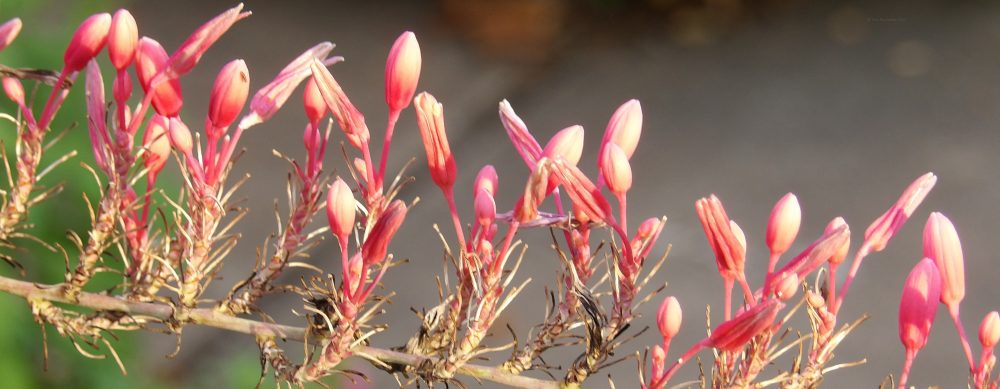


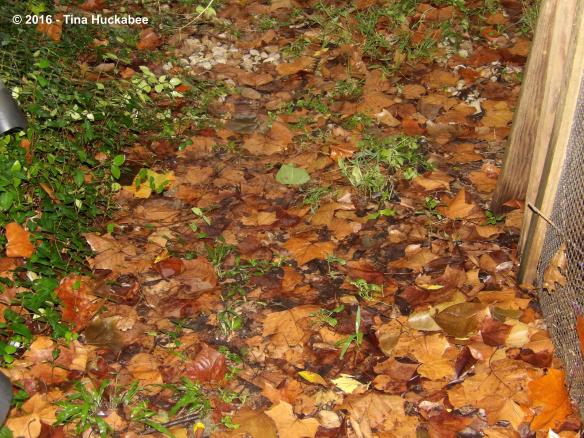

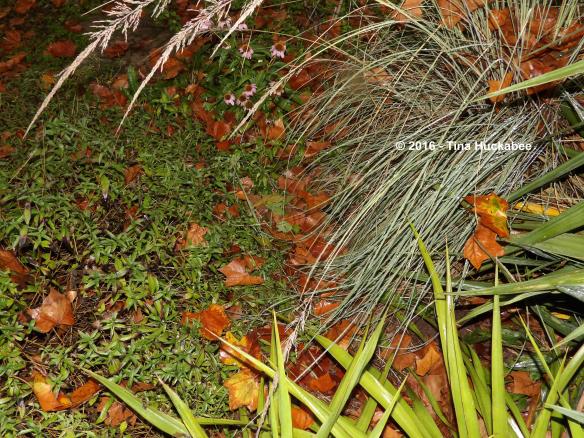
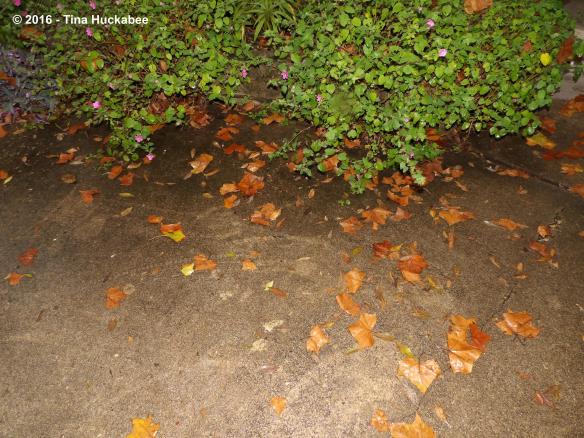


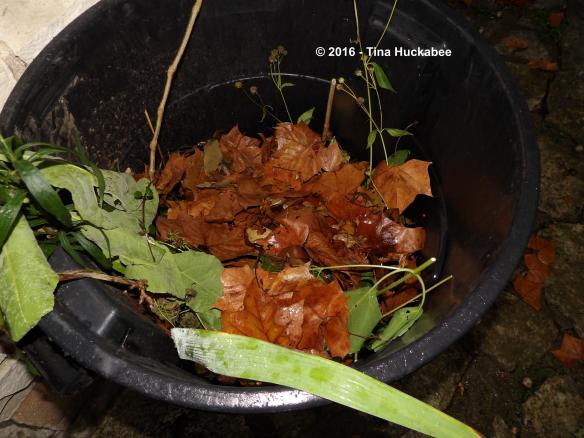


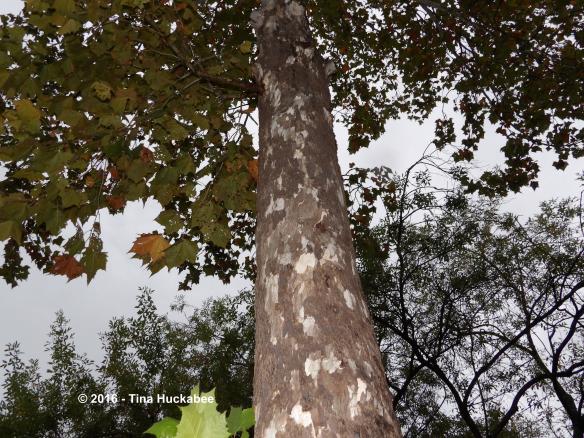

Sycamores are one of our favorite trees!!
LikeLike
Mine too!!
LikeLiked by 1 person
Tina su Sycamore es una maravilla de árbol: grande, alto y robusto. Ahora se pondrá precioso con los colores cambiantes de sus hojas. Y las hojas en el suelo serán el refugio de muchos pequeños animales. Saludos de Margarita.
LikeLike
Yes, the sycamore is a great tree–leaves for the critters and changing color for the gardener. 🙂
LikeLike
I like the shade of copper of the leaves! I know what you mean about the leaf cover being a little overwhelming–my garden is currently covered with Oak leaves. We leave the ones on the garden beds for winter mulch, but rake the ones in the grass into the woods. That way, we maintain the wildlife value, but don’t kill our turf grass. Thanks for highlighting this tree–I can see how it would be valuable for your garden. 🙂
LikeLike
The sycamore hasn’t quite turned the yellow that it often does, but with our wet year, that might well not happen. Ha! Fallen leaves can be annoying to my neat-freak tendencies, but I try to keep those in check. The leaves are how the cycle of “recycle” in nature works–and that’s our goal, isn’t it?
LikeLike
Beautiful♥
LikeLike
Thanks!
LikeLike
Yes, trees – particularly the sycamore (not sure if ours is the same as the American sycamore but it’s certainly very similar) – have a habit of awkwardly dropping their leaves. Ours likes to drop its leaves into our pond…!
Lovely post and pics as ever.
LikeLike
Yes, my leaves end up in the pond–and everywhere else! I do like the tree, but….
LikeLiked by 1 person
I’ve learned another tree! At least, I’ve learned the scientific name. I’ve always admired the sycamore, and found one in Kansas, in the bottomlands of the Tallgrass Prairie. It was a splendid specimen with wonderful white bark, those great, spreading limbs, and big, fat leaves (that no one will have to rake!)
Do the balls stay on the tree, or do they fall, too? Do the squirrels eat them? Sweet gum balls are such a pain — it would be a shame if sycamore balls are, too.
LikeLike
Sycamore are quite wide-spread throughout the eastern/southern part of North America. The balls disintegrate in spring–tiny whiffs of hairy, tufted seed float to the ground. Just afterwards, new ones begin forming.
LikeLiked by 1 person
What a great meme – to follow a tree… As for your Sycamore, I love its bark!
LikeLike
The sycamore does have lovely bark and this meme is a fun and educational one.
LikeLiked by 1 person
Your tree has beautiful colours (on the ground, at least) and the bark will look good all winter.
We are nearing the end of our sweeping up sweetgum and ash leaves in our garden now. Glad we haven’t got any plane trees/sycamores of our own. The London plane trees in the parks have huge amounts of glorious leaves (like yours), but I would hate to have to sweep them up.
Thanks so much for sharing 🙂
LikeLike
I can imagine that the sweetgum is a bit of a mess on the ground, but what pretty colors it has! I just returned from a trip to Oregon and then British Columbia, CA and the sweetgums were just gorgeous! Thank you for hosting!
LikeLike
I like your tolerant approach to gardening, and neat to hear about Dillo Dirt!
LikeLike
Dillo Dirt is great!! In fact, I’m just lazy. 🙂
LikeLike
Pingback: Tree following link box for November 2016 | The Squirrelbasket
How fast a year goes by! As you know, I love the sycamore; the last few weeks we’ve been cleaning leaves as well (mostly maples, some are flying in from the neighbours). For now I keep them all in a back corner where I discard all used potting soil, they make for great compost.
LikeLike
Yes, it’s flown by too quickly! I was in British Columbia for a bit of October and saw such beautiful color–in the trees and on the ground! Gorgeous! You’re right though, great compost–here’s to a healthy garden!
LikeLike
We are totally covered in leaves of all different kinds. One thing I like about them: instead of digging holes in my lawn when caching, the squirrels just move about a few leaves to cover the nuts with….
LikeLike
Yeah, once the leaves fall, there’s lots more rustling going on.
LikeLiked by 1 person